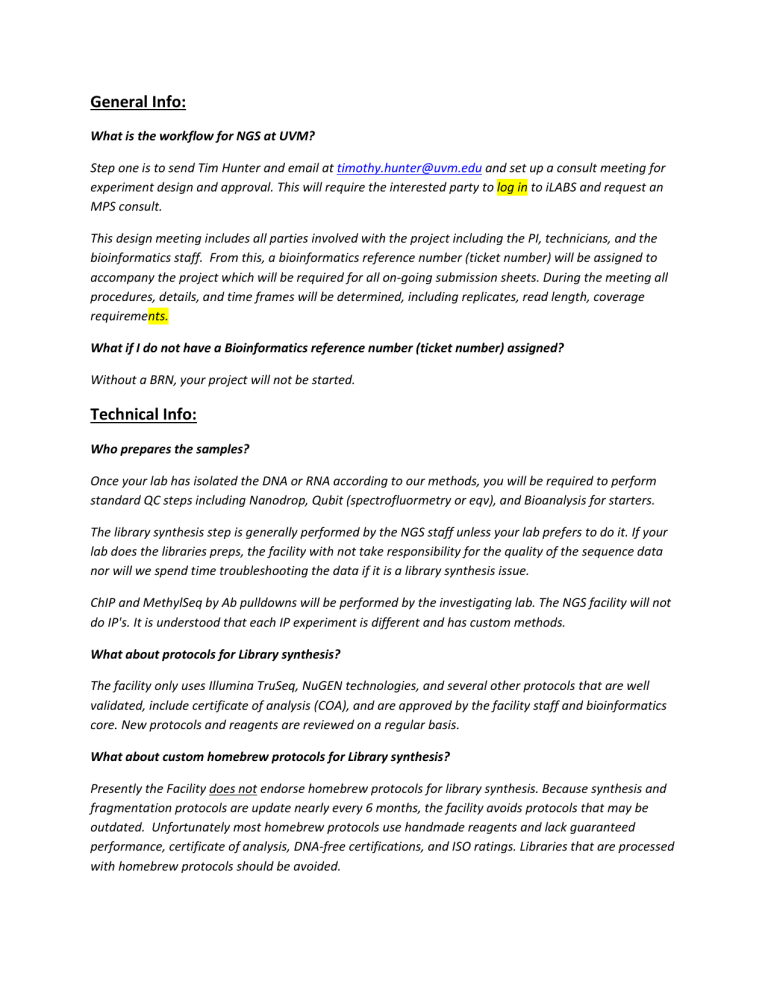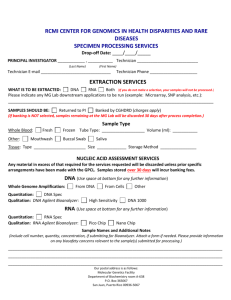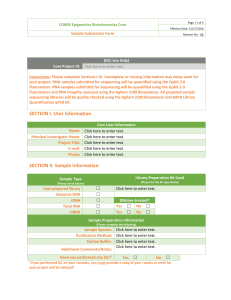General Info: What is the workflow for NGS at UVM? Step one is to

General Info:
What is the workflow for NGS at UVM?
Step one is to send Tim Hunter and email at timothy.hunter@uvm.edu
and set up a consult meeting for experiment design and approval. This will require the interested party to log in to iLABS and request an
MPS consult.
This design meeting includes all parties involved with the project including the PI, technicians, and the bioinformatics staff. From this, a bioinformatics reference number (ticket number) will be assigned to accompany the project which will be required for all on-going submission sheets. During the meeting all procedures, details, and time frames will be determined, including replicates, read length, coverage requirements.
What if I do not have a Bioinformatics reference number (ticket number) assigned?
Without a BRN, your project will not be started.
Technical Info:
Who prepares the samples?
Once your lab has isolated the DNA or RNA according to our methods, you will be required to perform standard QC steps including Nanodrop, Qubit (spectrofluormetry or eqv), and Bioanalysis for starters.
The library synthesis step is generally performed by the NGS staff unless your lab prefers to do it. If your lab does the libraries preps, the facility with not take responsibility for the quality of the sequence data nor will we spend time troubleshooting the data if it is a library synthesis issue.
ChIP and MethylSeq by Ab pulldowns will be performed by the investigating lab. The NGS facility will not do IP's. It is understood that each IP experiment is different and has custom methods.
What about protocols for Library synthesis?
The facility only uses Illumina TruSeq, NuGEN technologies, and several other protocols that are well validated, include certificate of analysis (COA), and are approved by the facility staff and bioinformatics core. New protocols and reagents are reviewed on a regular basis.
What about custom homebrew protocols for Library synthesis?
Presently the Facility does not endorse homebrew protocols for library synthesis. Because synthesis and fragmentation protocols are update nearly every 6 months, the facility avoids protocols that may be outdated. Unfortunately most homebrew protocols use handmade reagents and lack guaranteed performance, certificate of analysis, DNA-free certifications, and ISO ratings. Libraries that are processed with homebrew protocols should be avoided.
General Sequencing Info:
How long does a HiSeq Run Take?
After the libraries are prepared, the actual runtime on the instrument takes 5-9 days depending on whether it is paired end or single end sequencing and the read length needed. The true bottlenecks are not necessary sequencing run time but rather the time it takes to prepare enough libraries to fill an entire flow cell of 8 lanes. Each lane is reserved by different investigators. Therefore if only one investigator needs only one lane, he or she will need to wait until all the remaining lanes are spoken for.
How many reads do you get in one lane?
Each lane produces about 200 million reads. A read is defined as one DNA molecule that is sequenced to a length of 100 bases or, if doing a paired end read, 200 bases. Therefore it may be expected to get >20 gigabases of sequence data per lane?
What about read length?
Read length is decide by the customer. For microRNA, a read length of 36 bases is plenty unless you need information on snoRNA and ScaRNAs, as these are much longer. For whole genome sequencing, a maximum read length is required, such as a 200bp paired end.
What about read depth or coverage?
Many factors play in to this calculation. But generally RNAseq requires substantially higher coverage for quantitative differential gene expression such as 1000x. Whole genome sequencing, on the other hand, is generally not quantitative and may require 100X or even less. Several factors such as GC content also play a role as high GC may results in uneven coverage and require more. Coverage calculations will be determined in the consultation.
Does UVM accept outside work?
Yes, but it must be approved by the facility director.
Genome Wide Sequencing
How much DNA is needed and what are the requirements? gDNA isolated by most standard techniques is acceptable but should be RNase treated and purified and have a concentration of 100ng/ul. Standard column techniques work well. A 260/280 of >1.7 is recommended and quantitation should be done on a Nanodrop and Qubit spectrofluorometer.
Can I submit less than 100 ng/ul?
Yes, by special arrangements only. Be aware that the core may need to increase the recommended coverage in that case.
Do I need to know the GC content prior to submission of my bacteria?
Yes, this is very helpful when determining coverage requirements
Do I need to run my DNA out on a gel or use the Bioanalyzer before submission to the Core?
Yes, the core will need to see the size distribution prior to starting the library synthesis. This is because our library input size needs to be 300-400bp AFTER a fragmentation step. The fragmentation can only be done if we know the input size distribution.
What is the coverage and read length required?
200 base pair paired end is needed for GWS. Coverage depends on the PI needs and GC content.
Generally 100x coverage is acceptable but be aware the sequencing of repeat regions is not standard for the Illumina HiSeq due to the sequencing length limit.
RNAseq
How much Total RNA do I need to submit?
Presently the facility requests 1ug of total RNA but can on special request handle lower amounts. We have processed samples with as little as 300ng using the Illumina TruSeq protocol with fine results. The facility also uses the NuGEN RNAseq system that has allowed us to process 500ng of prokaryotic RNA.
What is the best way to isolate my RNA?
Preferably, a Trizol extraction followed by an in-tube DNase treatment followed by column-based cleanup with another DNase step (On-Column DNase treatment using the RNeasyMini) procedures work well. DNase treatment is critical. However, it is worth considering that many columns do not recover miRNA efficiently. See the Facility staff with additional questions
What about QC of my RNA
All RNA must be analyzed by the Bioanalyzer 2100 to obtain an integrity profile. Presently we are recommending a RIN of 5 or greater. All RNA should be quantitated using the Nanodrop and Qubit spectrofluorometer to obtain concentration and 260/280 and 230/260 values. RNA should have a
260/280 value of greater then 1.7.and a 230/260 less than 2. However this is highly dependent on the concentration of RNA
What about Prokaryotic RNA
Generally speaking prokaryotic RNA requires additional attention. This includes a qPCR validation step to assure that no DNA is present. This is because the Facility currently uses the NuGEN system which employs random priming. Therefore any DNA will be primed and amplified.
Should I use ribosomal reduction steps?
The RNAseq TruSeq reagents of Illumina have a poly A enrichment step and therefore the RiboZeroGold kit is not required. If you choose to preform a RiboZerGold step to farther reduce rRNA, you will be required to provide Bioanalyzer traces before and after as well as final concentrations.
Do I need to prove that my RNA is DNA free by qPCR?
Yes.
How many reads can I expect from an RNA sample and how many can I multiplex on one lane?
We suggest targeting 50 million reads for a eukaryotic sample. This means that you can multiplex 3-4 samples per lane. Prokaryotic sample may be multiplexed to 16 per lane.
ChIPSeq
What is the best way to fragment my sample?
The current state of the art employs the use of the Covaris ASA. This is a major improvement over probe sonication because it eliminates AT bias fragmentation and damaged epitopes due to excessive localized heating. We suggest you consider the TruChip method from Covaris inc.
Should I consider doing a formaldehyde crosslinking titration?
Absolutely! Methanol-free formaldehyde in the range of 0.25-1% is a typical range. Time exposure must also be considered.
What QC requirements are needed for a ChIP experiments?
All fragmented DNA must be run on the Bioanalyer to establish that a single peak is generated at a median of ~300bp. Samples generating a double peak do to improper fragmentation or over should be avoided unless accompanied by a matched reference.
Where Can I get information on ChIPSeq?
ChIPSeq projects should follow the guidelines set by ENCODE (Encyclopedia of DNA Elements whenever possible. However because each ChIP project is different, and requires different experimental designs and
QC, details will be discussed during the initial consultation.
Useful ENCODE links can be found below: http://www.ncbi.nlm.nih.gov/pmc/articles/PMC3431496/pdf/1813.pdf http://www.betacell.org/documents/administered/about/guidelines/ENCODE_BCBC_ChIP-
Seq_Standards_V01_20110503.pdf
What is the best method for ChIPSeq?
Most labs have their own protocols and methods to generate DNA. However once the DNA has been generated it may be submitted for low input library synthesis by the core lab
What controls do I need for ChIPSeq?
The following control should be considered but additional controls may be required depending on the result of the consultation:
1) Purified DNA of the IP must be run on the Bioanalyzer HS DNA chip.
2) Western blot analysis of the ChIP DNA and Mock IP DNA (using and Isotype control antibody) should be run.
3) qPCR for known targets in the ChIP and Mock DNA
4) Input DNA (genomic) and the mock IgG IP DNA should be run as a sample on the Illumina HiSeq.
How many reads do I need and what is the recommended read length?
5-30 million reads per sample is not uncommon but depends on what you are looking at. This will be decided at the initial consultation. Read length of 100 bases single end is acceptable, but this too depends on several factors including sheared DNA input size and specific needs of the principle investigator.
Metagenomics:
Does the facility perform metagenomic sequencing?
Yes. The facility has done many shotgun metagenomic samples. However, for amplicons sequencing of a targeted region such as 16s, the facility will handle as amplicon sequencing.
Other types of Sequencing:
Does the facility handle other types of sequencing such as amplicon sequencing, methylation sequencing, and small RNA sequencing?
Yes, however because of the variety of methods for each type, we will reserve details to the initial consultation.






